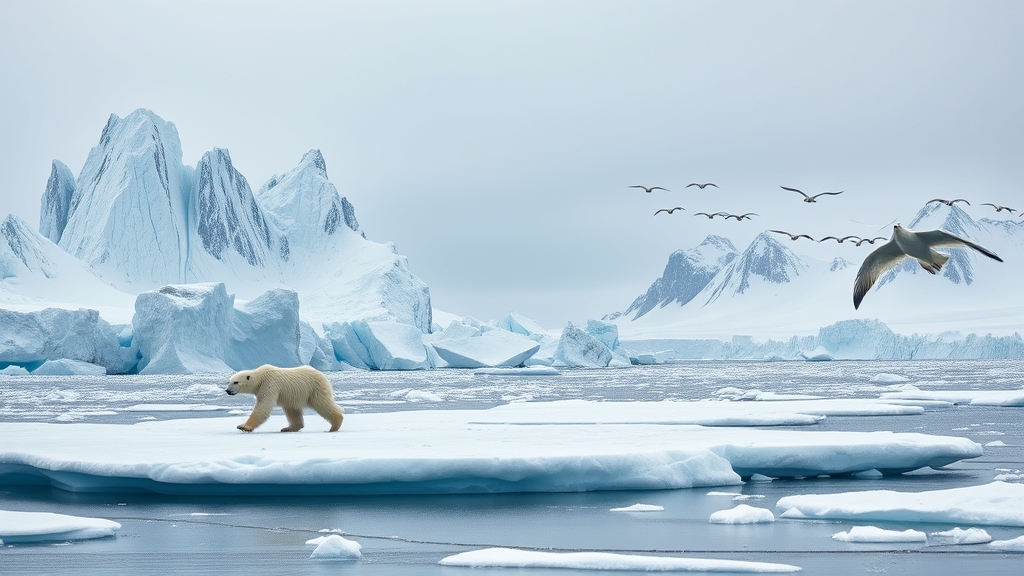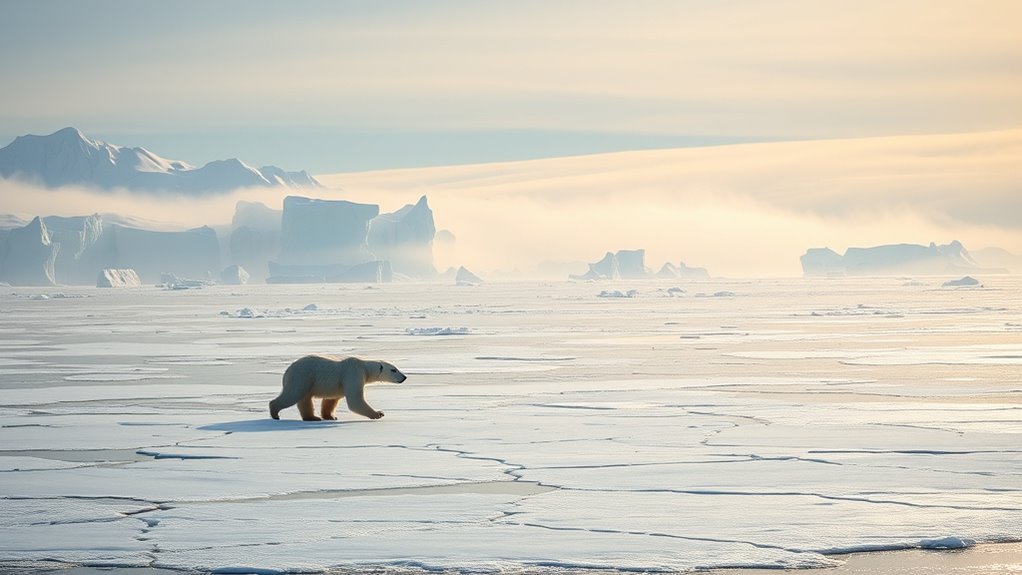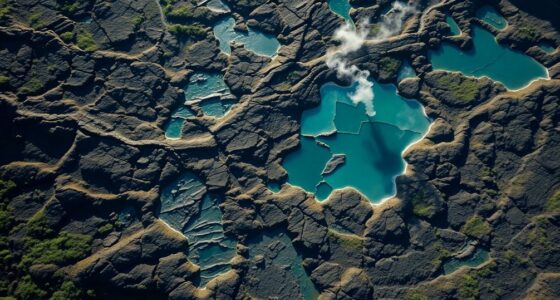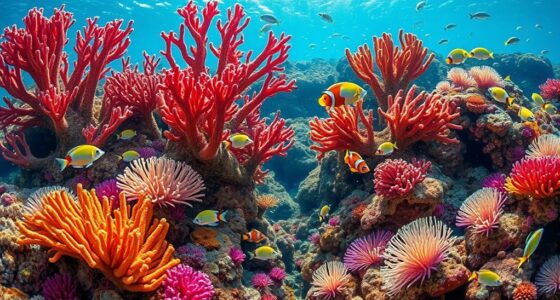The Arctic ecosystem is a fragile place facing serious threats from climate change. As ice melts faster each year, polar bears and other wildlife struggle to survive, relying on sea ice to hunt and thrive. Thawing permafrost releases greenhouse gases that fuel more warming, disrupting land and ecosystems. These changes also impact local communities and global climate patterns. To understand how these shifts influence the entire planet, keep exploring the essential connections beneath the ice.
Key Takeaways
- The Arctic ecosystem is a fragile environment shaped by extreme conditions, supporting unique species like polar bears that depend on sea ice.
- Climate change causes accelerated melting of sea ice, threatening wildlife, especially polar bears, and disrupting ecological balance.
- Melting permafrost releases greenhouse gases, intensifying global warming and destabilizing Arctic landforms and habitats.
- Environmental changes impact indigenous communities, Arctic infrastructure, and biodiversity, highlighting the ecosystem’s global significance.
- Urgent conservation efforts, including remote monitoring, are essential to mitigate irreversible damage and protect Arctic life.

Have you ever wondered what makes the Arctic ecosystem so unique? It’s a place of extreme conditions, where life adapts to relentless cold, shifting ice, and seasonal darkness. The Arctic is not just a frozen wasteland; it’s a vibrant, delicate environment that relies on a precise balance. One of the most iconic symbols of this ecosystem is the polar bear. These majestic predators depend heavily on sea ice to hunt for seals, their primary food source. As climate change accelerates, however, the ice is melting at an alarming rate. The shrinking ice platforms mean polar bears are forced to travel farther and expend more energy to find food, which threatens their survival. Their future hangs in the balance as the ice diminishes year after year. The melting ice isn’t just a threat to polar bears; it also signals the profound impact of climate change on the entire Arctic environment.
Permafrost melting is another critical aspect of the Arctic’s changing landscape. Permafrost is permanently frozen ground that holds vast amounts of organic material and greenhouse gases like methane and carbon dioxide. When the permafrost begins to thaw, these gases are released into the atmosphere, exacerbating global warming. This process creates a feedback loop: as the permafrost melts, more greenhouse gases enter the air, intensifying climate change and leading to further melting. The thawing ground also destabilizes ecosystems, causing collapses in landforms and affecting plant and animal habitats. You might not realize it, but these changes ripple through the entire environment, impacting everything from soil stability to local communities that rely on the land for their livelihoods. Additionally, the melting permafrost can accelerate the degradation of Arctic infrastructure, posing risks to human settlements and industry. The release of stored gases from permafrost melting further accelerates climate change, making it a critical concern for global efforts to reduce greenhouse emissions. In fact, advancements in AI security research are increasingly being used to monitor these environmental changes remotely, providing vital data for conservation efforts. These interconnected processes highlight the importance of global conservation strategies, such as protecting biodiversity hotspots and supporting sustainable development initiatives. You can see how fragile this ecosystem is, with each change triggering a cascade of effects. The loss of sea ice also affects indigenous peoples who depend on the ice for transportation and hunting. Their way of life is being reshaped by these rapid environmental shifts. Understanding these interconnected processes helps you grasp why the Arctic is on the frontlines of climate change. It’s a stark reminder that the health of this icy wilderness directly links to the health of our planet, urging urgent action to slow the process before irreparable damage occurs.
Frequently Asked Questions
How Does Arctic Climate Change Affect Global Weather Patterns?
You might notice that Arctic climate change influences global weather patterns through shifting Arctic jet streams, which control weather systems. As the ice melts, it weakens these jet streams, causing them to become more meandering. This leads to extreme weather, like cold spells or heatwaves, in various regions. Additionally, climate feedback loops from melting ice accelerate warming, further disrupting global climate stability and making weather patterns more unpredictable worldwide.
What Are Indigenous Communities Doing to Adapt to Arctic Changes?
Imagine standing strong as a mighty tree weathering fierce storms; that’s what indigenous communities do through cultural resilience and adaptation. They’re modifying traditional practices, incorporating new technologies, and sharing knowledge to survive changing conditions. By blending old wisdom with innovation, indigenous peoples maintain their identity while facing climate challenges. Their resilience not only sustains their way of life but also serves as an inspiring symbol of hope amid the shifting Arctic landscape.
How Do Melting Ice Sheets Influence Sea Level Rise?
Melting ice sheets substantially impact sea level rise through ice sheet dynamics, where increased melting causes more ice to flow into the oceans. As this ice melts and breaks away, it adds volume to sea levels, threatening coastal communities worldwide. You should recognize that these changes accelerate sea level implications, leading to flooding, erosion, and habitat loss. Understanding ice sheet dynamics helps explain how climate change directly influences global sea levels.
What New Species Are Emerging in the Arctic Due to Warming?
You’ll notice new species emerging in the Arctic as warming drives adaptation. Fish like Atlantic salmon and cod move northward, while invertebrates such as crabs and mollusks establish themselves in previously inhospitable areas. These Arctic adaptations alter the ecosystem, creating a dynamic environment. Your understanding of these new species helps recognize how climate change reshapes biodiversity, highlighting the importance of monitoring these changes to protect the fragile Arctic ecosystem.
How Can Technology Help Monitor Arctic Ecosystem Shifts?
Imagine your eyes turning into a satellite imaging camera, scanning the icy expanse. You can leverage satellite imaging and sensor networks to track shifts in Arctic ecosystems in real time. These tools act like digital detectives, revealing changes in ice cover, wildlife patterns, and temperature. By monitoring these shifts, you help scientists understand climate impacts better, enabling quicker responses and more effective conservation efforts in this fragile environment.
Conclusion
You stand at the edge of a shrinking Arctic, where every ice melt is like losing a piece of the planet’s soul. The fragile ecosystem’s fate depends on your actions, because the changes happening here are happening everywhere—faster than you can imagine. If you ignore these warning signs, you risk witnessing the most dramatic transformation in Earth’s history. The Arctic’s cry for help is loud; will you listen and act before it’s too late?









